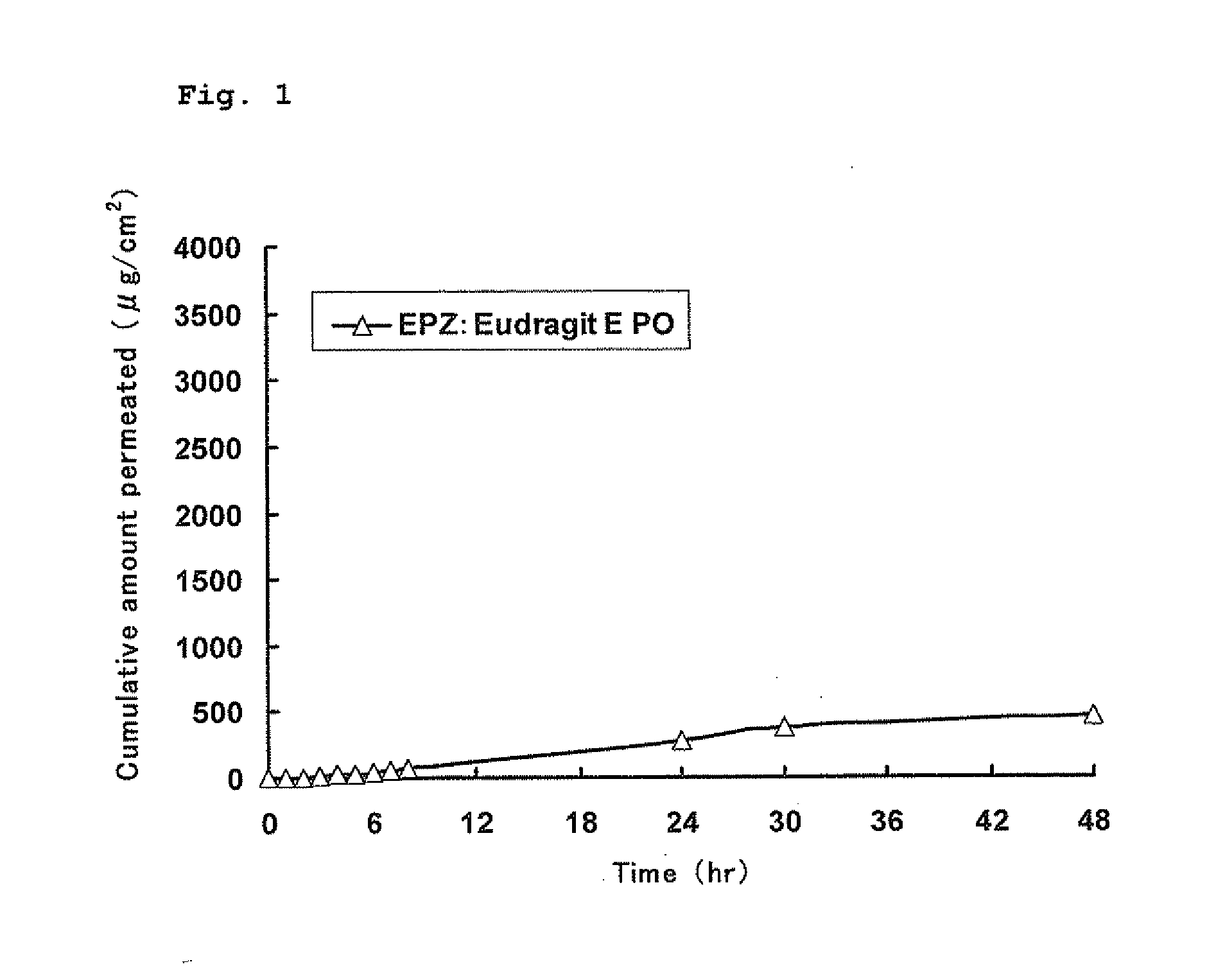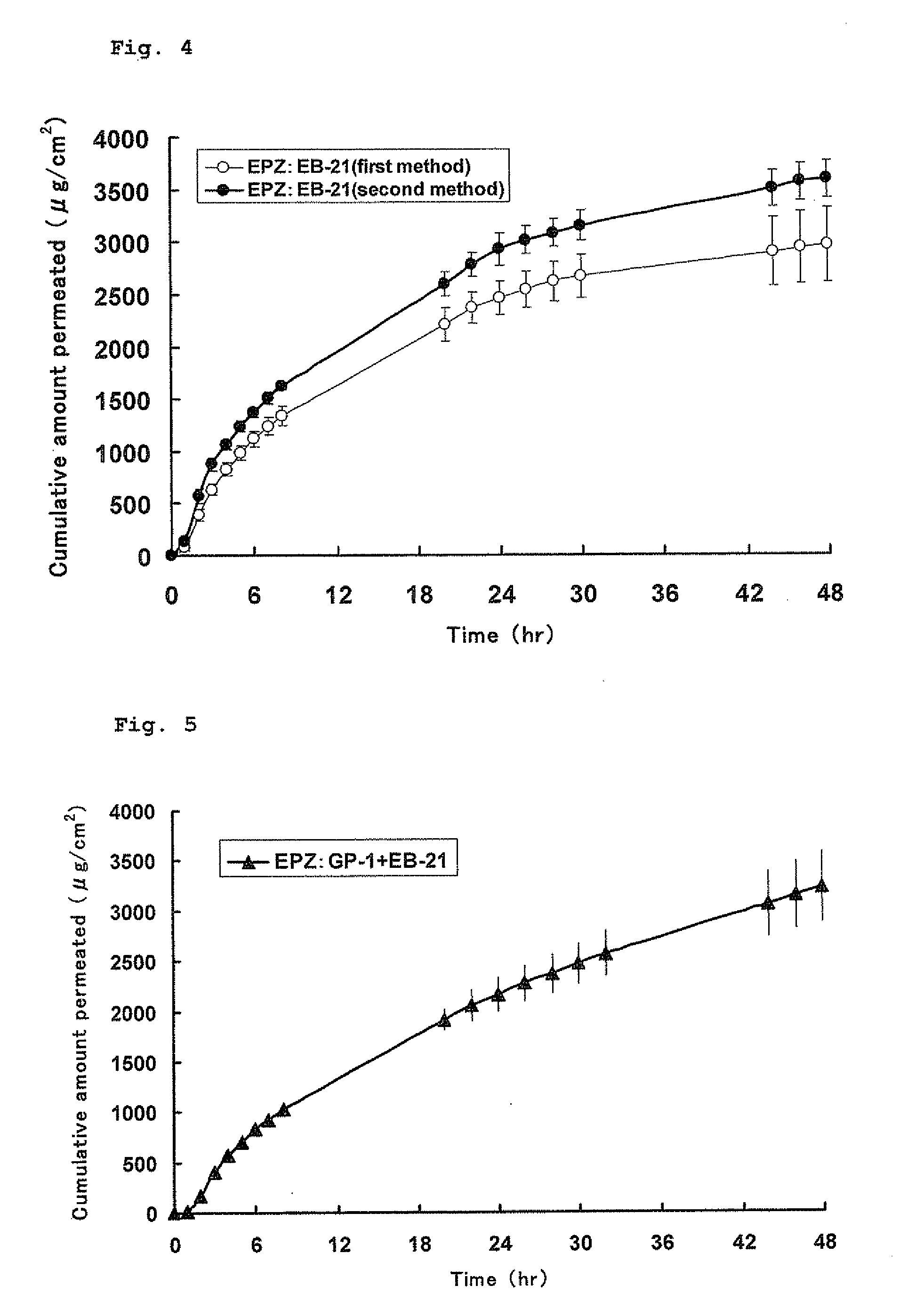Pharmaceutical composition for external use
a technology for pharmaceutical compositions and external use, applied in the direction of drug compositions, biocide, anti-inflammatory agents, etc., can solve the problems of poor absorption, low bioavailability, pain and inconvenience for patients, and achieve the improvement of excellent and the effect of improving the skin permeability of drugs
- Summary
- Abstract
- Description
- Claims
- Application Information
AI Technical Summary
Benefits of technology
Problems solved by technology
Method used
Image
Examples
example 1
Comparison Between Suspension and Organogel
[0051]1. Preparation of Each Sample
[0052](1) Eptazocine-Containing GP-1 Organogel
[0053]Into a test tube were added 63.56 mg of EPZ (2%), 124.73 mg of GP-1 (4%) and 153.47 mg of GEFA-C8 (5%) and further added 2677.55 mg of IPM to give a total amount of 3019.31 mg. The test tube was placed in a heating block which had been heated at 130° C. to heat the mixture solution. The test tube was occasionally taken out of the heating block and stirred with a vortex mixer to dissolve GP-1 uniformly. After GP-1 was dissolved, the heating block was set to a temperature of 80° C., and the resulting solution was cooled while stirring occasionally to mix uniformly. When the solution was cooled to 90° C. or less, it was taken out of the heating block and allowed to cool while stirring, so that an EPZ-containing organogel was obtained.
[0054]Into a test tube were added 84.42 mg of eptazocine hydrobromide (EPZ.HBr) (2% as EPZ), 120.85 mg of GP-1 (4%) and 147.96...
example 2
Preparation of Organogel
[0065]1. Preparation of Eptazocine-Containing Organogel
[0066](1) Eptazocine-Containing GP-1 Organogel (First Method)
[0067]Into a test tube were added 60.52 mg of EPZ (2%), 121.1 mg of GP-1 (4%) and 151.5 mg of GEFA-C8 (5%) and further added IPM to give a total amount of 3000.8 mg. The test tube was placed in a heating block which had been heated at 130° C. to heat the mixture solution. The test tube was occasionally taken out of the heating block and stirred to dissolve GP-1 uniformly. After GP-1 was dissolved, the heating block was set to a temperature of 80° C., and the solution was cooled while stirring occasionally to disperse the drug uniformly. When the solution was cooled to about 90° C., it was taken out of the heating block and allowed to cool while stirring, so that an organogel was obtained.
[0068](2) Eptazocine-Containing GP-1 Organogel (Second Method)
[0069]First, 100.53 mg of EPZ, 251.6 mg of GEFA-C8 and 2011.9 mg of IPM were taken and then mixed ...
example 3
Mouse Skin Permeation Studies of Organogel
[0088](1) Mouse Skin Permeation Studies of Eptazocine-Containing Organogel
[0089]The excised skin of a male hairless mouse (4 to 9 weeks of age) was set between a receptor phase and a donor phase of a Franz diffusion cell, and the receptor phase was filled with McIlvain buffer (pH 4.2). The rotation speed of a stirrer was about 650 rpm, and the experimental temperature was 32° C. Each EPZ-containing organogel prepared in the above 1. in Example 2 was applied in an amount of about 300 mg onto the skin (donor phase) which had been immersed in the McIlvain buffer for 1 hour in advance. The time of starting the application was regarded as 0 hour, and every 1 hour from 0 to 8 hours and every 2 hours from 20 to 30 hours and from 44 to 48 hours, sampling was carried out manually. The sampling was carried out by adding 0.5 mL of the McIlvain buffer which had been kept at 32° C. to the receptor phase of the Franz diffusion cell and removing the same a...
PUM
| Property | Measurement | Unit |
|---|---|---|
| Time | aaaaa | aaaaa |
| Mass | aaaaa | aaaaa |
| Mass | aaaaa | aaaaa |
Abstract
Description
Claims
Application Information
 Login to View More
Login to View More - R&D
- Intellectual Property
- Life Sciences
- Materials
- Tech Scout
- Unparalleled Data Quality
- Higher Quality Content
- 60% Fewer Hallucinations
Browse by: Latest US Patents, China's latest patents, Technical Efficacy Thesaurus, Application Domain, Technology Topic, Popular Technical Reports.
© 2025 PatSnap. All rights reserved.Legal|Privacy policy|Modern Slavery Act Transparency Statement|Sitemap|About US| Contact US: help@patsnap.com



